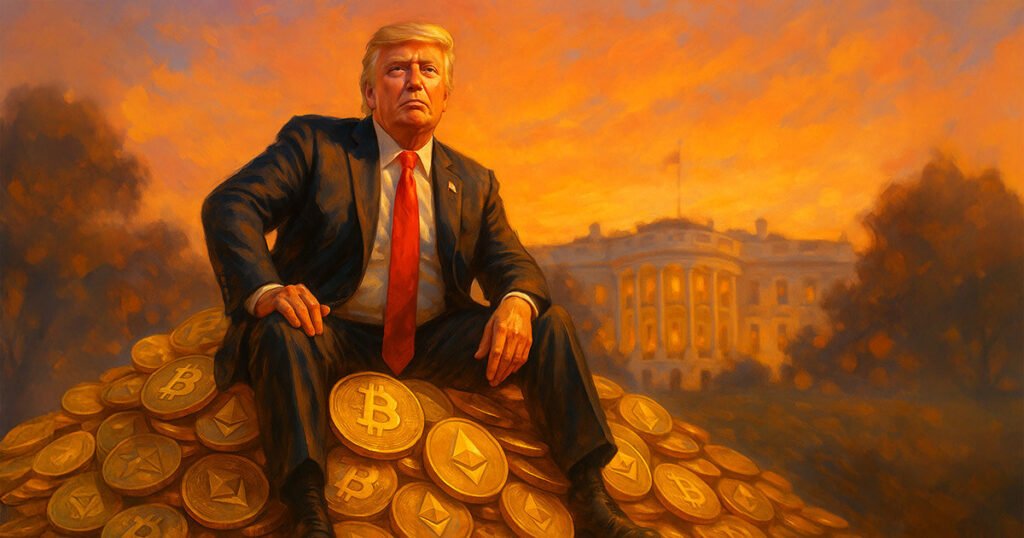US Crypto Investors Favor Trump’s Policies: A Survey Analysis
A recent survey by HarrisX reveals that over 70% of U.S. crypto investors express approval of the Trump administration’s approach to cryptocurrency policy. Conducted online from June 18 to June 19, the survey included responses from 1,096 adults, with 230 self-identified crypto investors providing insights into their perspectives on current regulations and economic conditions. The results indicate a significant correlation between government policy and investor sentiment, highlighting the growing importance of regulatory frameworks in shaping the digital asset landscape.
Among the crypto investor cohort, an impressive 81% reported actively following the administration’s crypto-related actions. Furthermore, 73% of those participants expressed general satisfaction with the direction of the crypto policy, indicating a perception that these regulations are beneficial for digital asset investments. In contrast, broader retail investor sentiment appears more mixed, with only 49% viewing the impact of these policies positively. The findings suggest a pronounced difference in awareness and sentiment between crypto investors and the general retail investing community, with policymakers encouraged to tailor communication strategies to bridge this gap.
Influence on Portfolio Decisions
Notably, the report highlights that 64% of U.S. crypto investors feel that the Trump administration’s crypto policies make them more likely to increase their exposure to digital assets. This sentiment aligns with a broader trend of increasing risk appetite, as 82% of the surveyed crypto investors believe that the current market represents a favorable entry point for investments—an increase of 9% since March. Additionally, a strong 73% of these investors indicated plans to make purchases within the next 30 days, reflecting heightened confidence and readiness to engage with the crypto market.
Investors’ bullish outlook extends beyond short-term trends; the report indicates that 60% anticipate price increases in the coming month, showcasing a 6% rise in optimistic expectations since March. Long-term projections are even more promising, with 68% of crypto investors expecting substantial gains over the next year. This overall positive sentiment within the crypto community underscores the unique influence that regulatory measures can have on investment behavior, especially in a volatile market environment.
Approval Across Policy Categories
Crypto-related policies have received notably high approval ratings compared to other areas of governance. The survey recorded a net approval score of +56% for cryptocurrency policy, clearly indicating that this sphere resonates powerfully with investors. When contrasted with other policy areas, such as reducing government costs and economic intervention, which garnered +48% and +39% approval respectively, the prominence of crypto policy stands out. This underscores a growing recognition of the digital asset space as a critical component of the broader economic landscape.
The appealing nature of crypto policy, as perceived by investors, suggests a robust foundation for further dialogue between policymakers and the cryptocurrency community. By continuing to engage with investors and addressing their concerns, the administration may further solidify its support among this demographic and foster an environment conducive to innovation and growth.
Awareness Disparity and Opportunities for Education
The survey highlights a significant disparity in awareness regarding crypto policies between crypto investors and the general public. Approximately 81% of crypto investors reported familiarity with the relevant policies, a stark contrast to just 47% of all retail investors and 34% of the broader population. This gap presents an invaluable opportunity for educational initiatives aimed at demystifying regulatory frameworks and empowering investors who may feel uncertain about the evolving crypto landscape.
HarrisX’s findings reflect an urgent need for targeted educational campaigns that convey complex regulatory issues clearly and effectively. Addressing these awareness gaps can not only lead to informed investing decisions but also promote a healthier dialogue surrounding cryptocurrency regulation, potentially attracting more individuals into the investment space.
Growing Satisfaction with Presidential Performance
A noteworthy trend revealed by the survey is the increase in overall satisfaction with President Trump’s performance among crypto investors. Approval ratings rose from 63% in March to 72% in June, reflecting a growing alignment between investor sentiment and governmental policy directions. This increase correlates with data suggesting an overall rise in market confidence, pointing to a potentially symbiotic relationship between government actions and investor perceptions.
The methodology employed by HarrisX included responses collected through multiple opt-in web panels, ensuring a demographic balance encompassing various age groups, genders, regions, races, and income levels. This data-driven approach enhances the reliability of the findings, allowing stakeholders to glean insights from a comprehensive cross-section of the population.
Conclusion
The findings from the HarrisX survey encapsulate a dynamic moment in the intersection of cryptocurrency and U.S. policymaking. With over 70% of crypto investors approving of the Trump administration’s policies, the report underscores the importance of regulatory clarity and communication in fostering investment confidence. As the crypto landscape continues to evolve, efforts to educate and engage a broader audience will be crucial in bridging awareness gaps and promoting a well-informed investment community.
By capitalizing on this momentum and maintaining an open line of dialogue with investors, policymakers can create an environment that nurtures innovation while addressing the unique challenges presented by the fast-paced world of digital assets. As attitudes toward cryptocurrency continue to shift, the implications for future policy and investment decisions will undoubtedly reverberate across economic landscapes for years to come.


